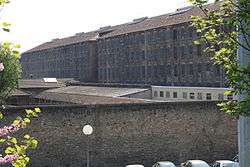Fresnes Prison

Fresnes Prison (Centre pénitentiaire de Fresnes) is the second largest prison in France, located in the town of Fresnes, Val-de-Marne South of Paris. It comprises a large men's prison (maison d'arrêt) of about 1200 cells, a smaller one for women and a penitentiary hospital.
Fresnes is one of the three main prisons of the Paris area, the Fleury-Mérogis Prison (Europe's largest prison) and the La Santé Prison (located in the centre of Paris) being the other two.
History
The prison was constructed between 1895 and 1898 according to a design devised by architect Henri Poussin. An example of the so-called "telephone-pole design," the facility was radically different from previous prisons. At Fresnes prison, for the first time, cell houses extended crosswise from a central corridor. The design was used extensively in North America for much of the next century.
During World War II, Fresnes prison was used by the Germans to house captured British SOE agents and members of the French Resistance. Held in horrific conditions, these prisoners were tortured, and some, such as Berty Albrecht (1893–1943), co-founder of the Combat movement, died there. As soon as the Allied forces broke through at Normandy and fought their way to liberate Paris, the Gestapo peremptorily killed prisoners at Fresnes. Jewish resistance fighter Marianne Cohn was murdered by axe wielding militants on 8 July 1944, and Suzanne Spaak, who was executed there on 12 August, less than two weeks before the city was liberated. Christopher Burney (1917–1980) was freed in 1945, and published Solitary Confinement, an account of his fifteen months there.
Squadron Leader Phil Lamason (1918–2012) of the RNZAF was the ranking officer and one of 168 allied airmen imprisoned here in 1944. They were also transferred to Buchenwald concentration camp just days before Paris was liberated.
Famous inmates, escapes and deaths
- Roman Czerniawski, creator of the Interallie network in France, was held in Fresnes prison after his arrest in November 1941.[1]
- Agnès Humbert (1894–1963), along with other members of the French Resistance, "Groupe du musée de l'Homme", were imprisoned and tried there (1941-42).[2]
- Edmond Debeaumarché was imprisoned there and was transported by train to Buchenwald.[3]
- SOE officers Peter Churchill (1909–1972) and Odette Sansom (1912-1995) were taken to Fresnes prison after their arrest in April 1943 in Saint-Jorioz near Annecy; Churchill was held prisoner until 13 February 1944, when he was transferred to Berlin for questioning. Sansom was tortured in Fresnes prior to being transported to Ravensbrück; she survived despite being sentenced to death.
- Captain Graham Hayes, MC (Operation Aquatint), a founding member of the "Small Scale Raiding Force", was kept in solitary confinement for nine months before his execution by firing squad on 13 July 1943.[4]
- Automobile industrialist Louis Renault, arrested by the provisional French government for collaborating with the Nazis, died there in 1944 under "questionable circumstances".
- Paul Touvier died of prostate cancer in 1996 at the Fresnes prison hospital during his incarceration for war crimes.
- Italian mobster Antonio Ferrara broke out of the prison in March 2003 in a commando-style raid. Members of his gang attacked the prison with rocket launchers and assault rifles, and they set fire to nearby cars in what is believed to have been intended as a distraction.[5] Arrested again four months later, Ferrara is now imprisoned in Fleury-Mérogis.
References
- ↑ Macintyre, Ben (2013). Double Cross: The True Story of the D-Day Spies. Broadway Books; ISBN 978-0307888778
- ↑ Agnès Humbert, (tr. Barbara Mellor) Résistance: Memoirs of Occupied France, London, Bloomsbury Publishing PLC, 2008; ISBN 978-0-7475-9597-7 (American title: Resistance: A Frenchwoman's Journal of the War, Bloomsbury, 2008)
- ↑ Sellier, Andre (2003). A History of the Dora Camp: The Untold Story of the Nazi Slave Labor Camp That Secretly Manufactured V-2 Rockets. Ivan R. Dee. pp. 113–14, 165. ISBN 9781461739494.
- ↑ Gordon Brown. Wartime Courage (pg. 62); ISBN 978-0-7475-9607-3
- ↑ "Jail escape forces French rethink". BBC News. 13 March 2003. Retrieved 4 January 2010.
4. Pierre d'Harcourt The Real Enemy. Longmans 1967